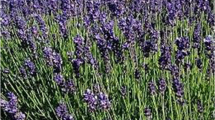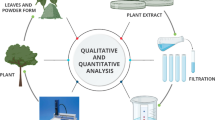Abstract
Introduction
Mikania laevigata Sch.Bip. ex Baker and Mikania glomerata Spreng. are medicinal plants popularly known as guaco, used for inflammatory diseases of the respiratory system, included in pharmaceutical formularies and often used without distinction. However, several studies show that the chemical composition varies between these species, as well as in plants are subjected to different environmental stresses. Few studies have been carried out with the volatile compounds of guaco, even less about the changes in volatile composition due to abiotic variation.
Objective
The aim of this work was to evaluate how volatile compounds vary according to the seasons and at different times of the day and if these compounds are influenced by the variations in the growth conditions such as: temperature, luminosity and water.
Methods
The headspace volatiles of the leaves were sampled by solid phase micro extraction and analyzed by gas chromatography–mass spectrometry. Untargeted metabolomic analysis of the resulting chromatograms and chemometrics was applied. The chemical profile of the volatiles of M. laevigata and M. glomerata were different; being clearly separated in the exploratory grouping analyzes (PCA), followed by analysis of variance of the marker compounds of both species.
Results
Only M. laevigata contained coumarin, considered to be the chemical marker of both species and to be responsible for the therapeutic activities. There was no significant difference between the morning and afternoon collections of either species. Coumarin, α-pinene and bicyclogermacrene were more intense in the volatiles of M. laevigata throughout the year and responsible for grouping the samples of this species. For M. glomerata, hexanal and 2-hexenal were responsible for grouping the samples and were more intense in all months. The growth conditions tested affected the intensity of specific compounds in the chromatograms. Some compounds were less intense with the increase of the temperature and in the plants subjected to full sunlight. However, certain volatile compounds—such as pinenes—were more intense in plants suffering drought.
Conclusion
The variation in composition between species of guaco was greater than those observed in the seasonal and cultivation studies, indicating that these species cannot be used indistinctly.




Similar content being viewed by others
References
Adams, R. P. (2007) Identification of essential oil components by gas chromatography/mass spectrometry (pp. 469). Allured Publishing Corporation.
Almeida, C. L., Xavier, R. M., Borghi, A. A., Santos, V. F., & Sawaya, A. C. H. F. (2017). Effect of seasonality and growth conditions on the content of coumarin, chlorogenic acid and dicaffeoylquinic acids in Mikania laevigata Schultz and Mikania glomerata Sprengel (Asteraceae) by UHPLC–MS/MS. International Journal of Mass Spectrometry, 418, 162–172. https://doi.org/10.1016/j.ijms.2016.09.016.
Bertolucci, S. K., Pereira, A. B., Pinto, J. E., de Aquino Ribeiro, J. A., de Oliveira, A. B., & Braga, F. C. (2009). Development and validation of an RP-HPLC method for quantification of cinnamic acid derivatives and kaurane-type diterpenes in Mikania laevigata and Mikania glomerata. Planta Medicinal, 75(3), 280–285. https://doi.org/10.1055/s-0028-1112195.
Bertolucci, S. K., Pereira, A. B., Pinto, J. E., de Oliveira, A. B., & Braga, F. C. (2013). Seasonal variation on the contents of coumarin and kaurane-type diterpenes in Mikania laevigata and M. glomerata leaves under different shade levels. Chemistry & Biodiversity, 10(2), 288–295. https://doi.org/10.1002/cbdv.201200166.
Boeger, M. R. T., Alquini, Y., & Negrelle, R. R. B. (2004). Características anatômicas da região nodal de estacas em diferentes fases de desenvolvimento de guaco (Mikania glomerata Sprengel – Asteraceae) e formação de raízes adventícias. Revista Brasileira de Plantas Medicinais, 6(2), 1–6.
Bolina, R. C., Garcia, E. D. F., & Duarte, M. G. R. (2009). Estudo comparativo da composição química das espécies vegetais Mikania glomerata Sprengel e Mikania laevigata Schultz Bip. ex Baker. Brazilian Journal of Pharmacognosy, 19(1), 294–298.
Brasil. (2011). Formulário de Fitoterápicos da Farmacopéia Brasileira 1ed. Brasilia: Agência Nacional de Vigilância Sanitária (ANVISA).
Can’ Ani, A., Mühlemann, J. K., Ravid, J., Masci, T., Klempien, A., Nguyen, T. T., et al. (2015). Petunia × hybrida floral scent production is negatively affected by high-temperature growth conditions. Plant, Cell and Environment, 38(7), 1333–1346. https://doi.org/10.1111/pce.12486.
Cappelaro, E. A., & Yariwake, J. H. (2015). HS-SPME-GC-MS analysis of volatile and semi-volatile compounds from dried leaves of Mikania glomerata Sprengel. Química Nova, 38(3), 427–430.
Costa, V. C. O., Borghi, A. A., Mayer, J. L. S., & Sawaya, A. C. H. F. (2018). Comparison of the morphology, anatomy, and chemical profile of Mikania glomerata and Mikania laevigata. Planta Medicinal, 84(3), 191–200. https://doi.org/10.1055/s-0043-119226.
De Melo, L. V., & Sawaya, A. C. H. F. (2015). UHPLC–MS quantification of coumarin and chlorogenic acid in extracts of the medicinal plants known as guaco (Mikania glomerata and Mikania laevigata). Revista Brasileira de Farmacognosia, 25(2), 105–110. https://doi.org/10.1016/j.bjp.2015.02.005.
Dos Santos, S. C., Krueger, C. L., Steil, A. A., Kreuger, M. R., Biavatti, M. W., & Wisniewski Junior, A. (2006). LC characterisation of guaco medicinal extracts, Mikania laevigata and M. glomerata, and their effects on allergic pneumonitis. Planta Medicinal, 72(8), 679–684. https://doi.org/10.1055/s-2006-931577.
Figueiredo, A.C., Barroso, J.G., Pedro, L.G. (2007). Plantas Aromáticas e Medicinais. Factores que afectam a produção. Potencialidades e Aplicações das Plantas Aromáticas e Medicinais. Thesis-University of Lisboa, pp. 1–18.
Kainulainen, P., Oksanen, P., Palomäki, V., Holopainen, J. K., & Holopainenet, T. (1992). Effect of drought and waterlogging stress on needle monoterpenes of Picea abies. Canadian Journal of Botany, 70(8), 1613–1616. https://doi.org/10.1139/b92-203.
Leite, M. G. R., Souza, C. L., Silva, M. A. M., Moreira, L. K. A., Matos, F. J. A., & Viana, G. S. B. (1993). Estudo farmacológico comparativo de Mikania glomerata Spreng. (guaco), Justicia pectoralis Jacq (anador) e Torresea cearensis (cumaru). Revista Brasileira de Farmácia, 74(1), 12–15.
Lima, H. R. P., Kaplan, M. A. C., & Cruz, A. V. M. (2003). Influência dos fatores abióticos na produção e variabilidade de terpenóides em plantas. Floresta e Ambiente, 10(2), 71–77.
Lopes, N. P., Kato, M. J., Andrade, E. H. A. A., Maia, J. G. S., & Yoshida, M. (1997). Circadian and seasonal variation in the essential oil from Virola surinamensis leaves. Phytochemistry, 46(4), 689–693. https://doi.org/10.1016/S0031-9422(97)00324-5.
Lorenzi, H., & Matos, F. J. D. A. (2008). Plantas medicinais no Brasil: nativas e exóticas (2nd ed.). Nova Odessa: Instituto Plantarum.
Meira, M. R., Martins, E. R., & Manganotti, S. A. (2012). Crescimento, produção de fitomassa e teor de óleo essencial de melissa (Melissa officinalis L.) sob diferentes níveis de sombreamento. Revista Brasileira de Plantas Medicinais, 14(2), 352–357. https://doi.org/10.1590/s1516-05722012000200015.
Milborrow, B. V. (2001). The pathway of biosynthesis of abscisic acid in vascular plants: a review of the present state of knowledge of ABA biosynthesis. Journal of Experimental Botany, 52(359), 1145–1164. https://doi.org/10.1093/jexbot/52.359.1145.
Morais, L. A. S. (2009). Influência dos fatores abióticos na composição química dos óleos essenciais. Horticultura Brasileira, 27(2), 4050–4063.
Nogués, I., Muzzini, V., Loreto, F., & Bustamante, M. A. (2015). Drought and soil amendment effects on monoterpene emission in rosemary plants. Science of the Total Environment, 538, 768–778. https://doi.org/10.1016/j.scitotenv.2015.08.080.
Passari, L. M. Z. G., Scarminio, I. S., & Bruns, R. E. (2014). Experimental designs characterizing seasonal variations and solvent effects on the quantities of coumarin and related metabolites from Mikania laevigata. Analytica Chimica Acta, 821, 89–96. https://doi.org/10.1016/j.aca.2014.03.003.
Pavarini, D. P., Pavarini, S. P., Niehue, M., & Lopes, N. P. (2012). Exogenous influences on plant secondary metabolite levels. Animal Feed Science and Technology, 176(1–4), 5–16. https://doi.org/10.1016/j.anifeedsci.2012.07.002.
Pereira, A. M. S., Câmara, F. L. A., Celeghini, R. M. S., Vilegas, J. H. Y., Lanças, F. M., & França, S. C. (2000). Seasonal variation in coumarin content of Mikania glomerata. Journal of Herbs, Spices e Medicinal Plants, 7(2), 1–10. https://doi.org/10.1300/J044v07n02_01.
Pinto-Zevallos, D. M., Martins, C. B. C., Pellegrino, A. C., & Zarbin, P. H. G. (2013). Compostos orgânicos voláteis na defesa induzida das plantas contra insetos herbívoros. Química Nova, 36(9), 1395–1405. https://doi.org/10.1590/S0100-40422013000900021.
Salek, R. M., Steinbeck, C., Viant, M. R., Goodacre, R., & Dunn, W. B. (2013). The role of reporting standards for metabolite annotation and identification in metabolomic studies. Gigascience, 2(1), 13. https://doi.org/10.1186/2047-217X-2-13.
Silva, F., Satos, R. H. S., Diniz, E. R., Barbosa, L. C. A., Casali, V. W. D., & Lima, R. R. (2003). Teor e composição do óleo essencial de manjericão (Ocimum basilicum L.) em dois horários e duas épocas de colheita. Revista brasileira de plantas medicinais, 6(1), 33–38.
SUPELCO-SIGMA, A. solid phase microextraction (SPME). Retrieved October 25, 2017 from http://www.sigmaaldrich.com/analytical-chromatography/sample-preparation/spme.html.
Taiz, L., & Zeiger, E. (2013). Fisiologia Vegetal (5th ed.). Porto Alegre: Artmed.
Wallaart, E. T., Beekman, A. C., & Quax, W. J. (2000). Seasonal variation of artemisinin and its biosynthetic precursor in plants of Artemisia annua. Planta Médica, 66(1), 57–62. https://doi.org/10.1055/s-2000-11115.
Acknowledgements
Thanks to Professor Eberlin, Laboratory ThoMSon for use of the GC–MS equipment; CPQBA, UNICAMP for the plants; and CNPq and CAPES for financial support.
Author information
Authors and Affiliations
Contributions
VAU performed the plant experiment, data collection and analysis; AS planned and supervised the research. Both authors wrote the manuscript.
Corresponding author
Ethics declarations
Conflict of interest
The authors confirm that there are no conflicts of interest, no human or animal participants were involved in this study and all financial support has been declared.
Additional information
Publisher's Note
Springer Nature remains neutral with regard to jurisdictional claims in published maps and institutional affiliations.
Electronic supplementary material
Below is the link to the electronic supplementary material.
Rights and permissions
About this article
Cite this article
Ueno, V.A., Sawaya, A.C.H.F. Influence of environmental factors on the volatile composition of two Brazilian medicinal plants: Mikania laevigata and Mikania glomerata. Metabolomics 15, 91 (2019). https://doi.org/10.1007/s11306-019-1546-x
Received:
Accepted:
Published:
DOI: https://doi.org/10.1007/s11306-019-1546-x




